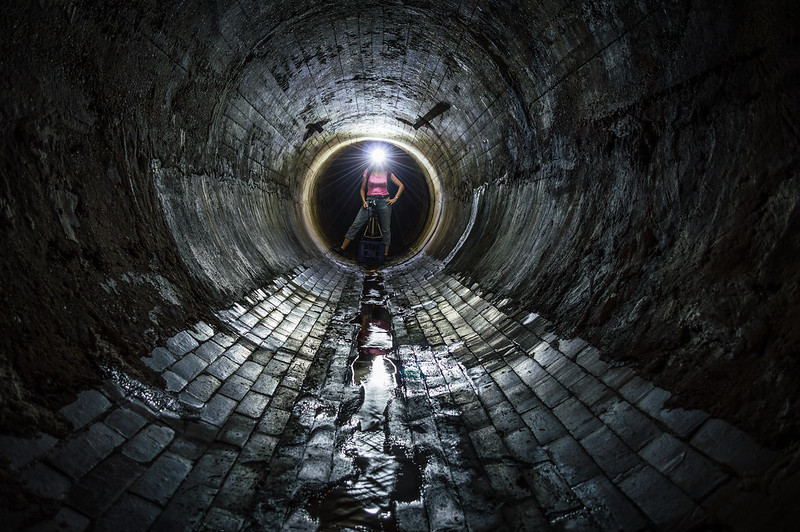Archive for the ‘Decisions’ Category
Skillful Awareness
 When do you bring your whole self to the endeavor? You can’t do this every time, and that’s okay.
When do you bring your whole self to the endeavor? You can’t do this every time, and that’s okay.
What are the conditions that cause you to engage fully? Full engagement is expensive. Spend wisely.
What about the situation causes you to run toward the problem? Solve the right ones, but leave some for the rest of us.
Which situations bring out the best in you? Sometimes your best isn’t very good, and that’s okay.
When do you block yourself from jumping into the adventure? All adventures aren’t worth the jump. Block wisely.
What are the conditions that cause you to phone it in? Sometimes the best choice is a phone call.
What about the situation causes you to give others a chance to run toward the problem? There’s nothing wrong with that. Save yourself for the right problems.
Which situations demand that you protect your best self? It’s okay to protect yourself and live to fight another day. That’s why they make bulletproof vests.
Sometimes we get caught up in the heat of battle and bring our energy in an unskillful way. And sometimes we are lulled into inaction when bringing our energy is the more skillful action.
I have found that maintaining awareness helps me allocate my energy wisely and skillfully.
May you be aware of your surroundings and your self.
Image credit – Jan Mosimann
Decisions, Decisions, Decisions
 If a decision can be unmade, it’s okay to make it quickly.
If a decision can be unmade, it’s okay to make it quickly.
Delaying a decision is a decision.
When a decision remains unmade, there’s a reason. However, that reason is often unspoken.
The effort to make the right decision is proportional to the consequences of getting it wrong.
Decisions are sometimes made without the non-deciders realizing that they were made.
Trouble arises when the decision maker is not the customer of the consequences.
Decisions are made slowly when people are afraid to make them.
When you don’t know a decision was made, you’ll continue to behave as if it wasn’t.
If five people are responsible for the decision, who is responsible for the decision?
Even if you are unaware that a decision was made, you’ll likely be expected to behave as if you knew it was.
If no decisions will be made at the meeting, don’t go. Just read the minutes.
Documenting decisions is not standard work, but I think it should be.
Decisions can be made, not made, unmade, re-made, and re-unmade.
Decisions aren’t decisions until behavior aligns with them.
When a decision is yet to be made, you can influence the decision by behaving as if it was made in your favor.
If you wait long enough, the decision will make itself.
Image credit — yawning hunter
Do More Than Keep The Score
 Sometimes when I have a good idea, my body recognizes it before my mind does. I believe my body has been doing this since I was young, but only over the last five years have I developed sufficient body awareness to recognize the sensation my body generates. And now that I know the sensation is a signal, I know my body knows more than I do.
Sometimes when I have a good idea, my body recognizes it before my mind does. I believe my body has been doing this since I was young, but only over the last five years have I developed sufficient body awareness to recognize the sensation my body generates. And now that I know the sensation is a signal, I know my body knows more than I do.
My body’s signaling system is usually triggered during a conversation with someone I trust. While they are speaking to me, one or two of their words help my body flip the “knowing switch” and send its signal. Sometimes I stop listening and wait for the idea to come to my awareness. Sometimes I say out loud, “My body thinks there’s something important in what you said.” Sometimes the signal and idea come as a pair, and I tell my friend about the idea after they finish their sentence. All this takes some time for my coworkers and friends to understand and become comfortable.
My body can also send signals when it recognizes wrong paths or approaches that will cause conflict or confusion. It’s a colder sensation than the one described above, and the coldness distinguishes it as a signal of potential wrongness, conflict, or confusion. Like above, it’s usually triggered during a conversation where a coworker’s words help my body flip its knowing switch and send the cold sensation. Sometimes I stop listening and wait for the knowing to arrive. Sometimes I acknowledge I just received a knowing signal. And sometimes I tell my friend about the knowing as soon as there’s an opening. This, too, takes time for others to understand and become comfortable.
For my body to be able to do this for me, it must be well-rested, well-exercised, and grounded. To do this, my body must be standing on emotional bedrock.
I think I’m more effective because I can connect with my body’s signals. I can become aware of better ideas, I can become aware of skillful approaches, and I can become aware of ways to protect my friends from conflict and confusion.
Bessel van der Kolk says The Body Keeps The Score, and I agree. And with deep calm and awareness, I think the body can do much more.
Image credit — darkday
What makes a strategic plan strategic?
 X: We need a strategic plan.
X: We need a strategic plan.
Me: Why do you need one of those?
X: Everybody needs a strategic plan.
Me: Okay. That didn’t work. Let me try it another way. What makes a plan strategic?
X: You start with a strategy and you create a plan to make it happen over the next three years.
Me: So, you plan out the next three years?
X: Yes. Or four.
Me: Doesn’t the plan assume you know how the Universe will behave over the next three years?
X: We know our market, we know our customers, we know our technology, and we make a three-year plan.
Me: And what if something changes, like COVID, tariffs, or a new competitor brings to market something that obsoletes your best product?
X: You can’t plan for that.
Me: Exactly.
X: You’re talking in circles! What do you mean?
Me: If your three-year plan can’t plan for unplanned things, what kind of plan is that?
X: I told you. It’s a strategic plan.
Me: Hmm. Let me try that again. What happens when something unexpected arises and your plan needs to change?
X: It’s a strategic plan. Those don’t change.
Me: Arrg. Do you mean the plan should change, but you don’t make the change? Or strategic plans never change?
X: Strategic plans don’t change because they’re strategic. We put a lot of time into creating them.
Me: They don’t change because they take a lot of time and effort to create?
X: Well, yes. We have long planning meetings, and our best people spend a lot of time creating it.
Me: Do you think the Universe cares how long it took you to create your plan?
X: There you go again with the Universe thing.
Me: What I mean by that is there are many factors outside your control. It’s a big world out there. And you can’t plan for everything.
X: What do you mean? We put everything in the strategic plan.
Me: That’s not the type of everything I’m talking about. I’m talking about things outside your control that you cannot possibly know.
X: Are you saying we don’t know what we’re doing?
Me: No, I’m saying you know everything you’re going to do over the next three years. And that’s the problem.
X: You are frustrating. First you tell me it’s impossible to plan for everything, then you tell me we have a problem because we plan for everything. What’s wrong with you?
Me: That’s the right question. There’s a lot wrong with me. I have a good idea that turns out to be wrong, so I change my plan. I think I understand what’s going on, but I learn that I’m wrong, so I change my plan. I have a plan, but something unexpected happens and turns my plan from good to wrong, so I change it, even if the plan is strategic, whatever that means.
Image credit — Geoff Henson
It’s time for the art of the possible.
 Tariffs. Economic uncertainty. Geopolitical turmoil. There’s no time for elegance. It’s time for the art of the possible.
Tariffs. Economic uncertainty. Geopolitical turmoil. There’s no time for elegance. It’s time for the art of the possible.
Give your sales team a reason to talk to customers. Create something that your salespeople can talk about with customers. A mildly modified product offering, a new bundling of existing products, a brochure for an upcoming new product, a price reduction, a program to keep prices as they are even though tariffs are hitting you. Give them a chance to talk about something new so the customers can buy something (old or new).
Think Least Launchable Unit (LLU). Instead of a platform launch that can take years to develop and commercialize, go the other way. What’s the minimum novelty you can launch? What will take the least work to launch the smallest chunk of new value? Whatever that is, launch it now.
Take a Frankensteinian approach. Frankenstein’s monster was a mix and match of what the good doctor had scattered about his lab. The head was too big, but it was the head he had. And he stitched onto the neck most crudely with the tools he had at his disposal. The head was too big, but no one could argue that the monster didn’t have a head. And, yes, the stitching was ugly, but the head remained firmly attached to the neck. Not many were fans of the monster, but everyone knew he was novel. And he was certainly something a sales team could talk about with customers. How can you combine the head from product A with the body of product B? How can you quickly stitch them together and sell your new monster?
Less-With-Far-Less. You’ve already exhausted the more-with-more design space. And there’s no time for the technical work to add more. It’s time for less. Pull out some functionality and lots of cost. Make your machines do less and reduce the price. Simplify your offering and make things easier for your customers. Removing, eliminating, and simplifying usually comes with little technical risk. Turning things down is far easier than turning them up. You’ll be pleasantly surprised how excited your customers will be when you offer them slightly less functionality for far less money.
These are trying times, but they’re not to be wasted. The pressure we’re all under can open us up to do new work in new ways. Push the envelope. Propose new offerings that are inelegant but take advantage of the new sense of urgency forced.
Be bold and be fast.
Image credit — Geoff Henson
When I’m Asked To Take On New Work
 Here are the questions I ask myself when I’m asked to take on new work….
Here are the questions I ask myself when I’m asked to take on new work….
Do I know what the work is all about?
Is it well-defined?
Would it make a big difference if the work is completed successfully?
Would it make a big difference if it’s not?
Is it clear how to judge if the work is completed successfully?
Is the work important and how do I know?
Is it urgent? (The previous question is far more important to me.)
Is there more important work?
Who would benefit from the work and how do I feel about it?
Would I benefit and how do I feel about it?
Am I uniquely qualified or can others do the work?
Am I interested in the work?
Would I grow from the work?
Who would I work for?
Who would I work with?
Would my career progress?
Would I get a raise?
Would I spend more time with my family?
Would I spend more time in meetings?
Would I travel more?
What does my Trust Network think?
Would I have fun? (I think this is a powerful question.)
These aren’t the questions you should ask yourself, but I hope the list helps you develop your own.
Image credit — broombesoom
Effectiveness Before Efficiency
 Efficient – How do we do more projects with fewer people?
Efficient – How do we do more projects with fewer people?
Effective – Let’s choose the right project.
Would you rather do more projects that miss the mark or fewer that excite the customer?
Efficient – How do we finish the project faster?
Effective – Let’s fully staff the project.
Would you rather burn out the project team or deliver on what the customer wants?
Efficient – How do we reduce product cost by 5%?
Effective – Let’s make customers’ lives easier.
Would you rather reduce the cost or delight the customer?
Efficient – How can we go faster?
Effective – Let’s get it right.
Would you rather go fast and break things or get it right for the customer?
Efficient – How many projects can we run in parallel?
Effective – Let’s fully staff the most important projects.
Would you rather get halfway through four projects or complete two?
Efficient – How do we make progress on as many tasks as possible?
Effective – Let’s work on the critical path.
Would you rather work on things that don’t matter or nail the things that do?
Efficient – How can we complete the most tasks?
Effective – Let’s work on the hardest thing first.
Would you rather learn the whole thing won’t work before or after you waste time on the irrelevant?
If there’s a choice between efficiency and effectiveness, I choose effectiveness.
Image credit — Antarctica Bound
Why We Wait
 We wait because we don’t have enough information to make a decision.
We wait because we don’t have enough information to make a decision.
We wait until the decision makes itself because no one wants to be wrong.
We wait for permission because of the negative consequences of being wrong.
We wait to use our judgment until we have evidence our judgment is right.
We wait for support resources because they are spread over too many projects.
We wait for a decision to be made because no one is sure who makes it.
We wait to reduce risk.
We wait to reduce costs.
We wait to move at the speed of trust.
We wait because too many people must agree.
We wait because disagreement comes too slowly.
We wait for disagreement because we don’t subscribe to “clear is kind.”
We wait when decisions are unmade.
We wait because there is insufficient courage to stop the bad projects.
We wait to stop things slowly.
We use waiting as a slow no.
We wait to reallocate resources because even bad projects have momentum.
We wait when we dislike the impending outcome.
We wait for the critical path.
We wait out of fear.
Image credit — Sylvia Sassen
Why Hardware Is Hard For Startups And What to Do About It
 Software may be eating the world, but the hardware elements of a startup’s work define when lunch is served.
Software may be eating the world, but the hardware elements of a startup’s work define when lunch is served.
Hardware takes longer than software. With hardware, after the product and its parts are designed, companies are vetted/selected to make the parts; contracts are signed to make the parts; the parts are made; the parts are shipped; the parts are received; the parts are inspected; and the parts are put in their locators. Then, the manufacturing process is defined, the manufacturing tooling is designed and purchased; the manufacturing documentation is created; the final test system is designed and built; and the parts are assembled into the product. Then, the product is run through final test and tested for robustness. After it’s learned the manufacturing process created too much variation and the insufficient robustness manifests, the manufacturing process and its documentation are changed to reduce variation; the parts that failed are redesigned, purchased, made, shipped, and received; and the next iteration of the product is built and tested. This process is repeated until the product is robust and the manufacturing process is repeatable. This is why hardware takes longer than software.
If the software is done but the hardware isn’t, the software must wait for the hardware and the customer must wait for the finished product. To get the hardware done faster, recognize that redesign loops are part of the game and invest in the capability to iterate quickly. Line up the suppliers to make parts quickly; keep utilization low on the support resources so they can jump on the work when it arises (think fire stations who can respond quickly when there’s a fire); and avoid part-time resources on the critical path. There may be other things to focus on, but only after taking care of these three.
Software may be eating the world, but the hardware elements of a startup’s work govern the cost of getting to the dinner table.
Hardware costs more to make than software. Hardware is made of steel, aluminum, injection molded plastics, and rare earth elements, all of which cost money. And because startups do things that have not been done before, the materials can be special (costly). And unlike software, the marginal cost of an incremental unit is non-zero. With hardware, if you want to make another one you’ve got to buy more of the materials; you have to pay people to make it; you have to buy/build the manufacturing system; you have to buy the measurement systems and engineering infrastructure; and you have to pay people to break-test-fix the product until it’s ready.
What’s a startup to do?
To do hardware faster, focus on learning. And to do hardware more cost-effectively, focus on learning.
For both time and money, learning efficiency is a good starting point. The most efficient learning is the learning you don’t have to do, so be ruthless in how you decide what you DON’T learn. Where possible, declare all but the most vital problems as annoyances and save them for later. (Annoyances don’t require learning.) This will concentrate your precious resources on fewer problems, improve your learning rate, and keep costs to a minimum.
Here’s a good test to decide if the learning is worth learning. Ask yourself “If we accomplish this learning objective, how will the customer benefit?” If there is low or no customer benefit, say no to the learning objective. If there is medium customer benefit, say no to the learning objective. If there is significant customer benefit, do the learning.
For those learning objectives that make it through the gauntlet, learn what you need to learn, but no more. To do this, create a formal learning objective: “We want to learn [enter learning objective here].” With learning objectives, the tighter the better. And define the criteria for decision making: “If the result of the test is [define objective measurement here], we will decide [enter decision here].” With decision criteria, the clearer the better.
Learn effectively, not elegantly. Be bold, rough, and crude with how you learn. Design tests that take advantage of the resources you have on hand so you can learn quickly. If you can run a crude test in one hour and the perfect test will take a week, run three crude tests and be done by the end of the day.
Learn with less confidence and more judgment. If a wrong decision can be overcome quickly and with low cost, be less confident and use more judgment.
Whether driven by hardware, software, or the integration of both, project completion is governed by the critical path. And with longer time constants, it’s more likely that the hardware defines the critical path. The total cost of the project is the sum of the three costs: software, hardware, and integration. And because hardware requires expensive materials, factories, engineering labs, people to run the tests, and people to make the products, hardware is likely a large percentage of the project costs.
Image credit — Günter Hentschel
Did you do anything different today?
 In that familiar situation, how did you respond in an unfamiliar way?
In that familiar situation, how did you respond in an unfamiliar way?
Instead of your usual yes, did you say no?
With your regular chair available in the conference room, why not sit in a different one?
Instead of using your right hand to brush your teeth, why not try your left? How would it feel?
When someone misbehaved in a meeting, how did you respond? Or did you?
If no one recognized your different behavior, was it different enough? Why not rerun the experiment?
With the same choices on the menu, what’s in the way of asking for a special order?
Instead of going to the meeting, did you ask someone to go in your place as a growth opportunity?
When you pay attention, you notice more opportunities to demonstrate novelty. Do you pay attention?
If it didn’t create a sensation in your body, did you do anything novel?
When you saw someone respond differently, did they like it when you praised their behavior?
When you have a chance to help someone be successful, why not help them?
When you have the chance to make a different choice, why not make it?
When you have a chance to respond differently, why not do it?
When you have a chance to feel uncomfortable, why not feel it?
One more question for you — What novelty did you demonstrate today?
Image credit — Mike Beales
When in doubt, look inside.
 When we quiet our minds, we can hear our bodies’ old stories in the form of our thoughts.
When we quiet our minds, we can hear our bodies’ old stories in the form of our thoughts.
Pay attention to our bodies and we understand our minds.
Our bodies give answers before our minds know the questions.
If we don’t understand our actions, it’s because our bodies called the ball.
The physical sensations in our bodies are trailheads for self-understanding.
Our bodies’ old stories govern our future actions.
If a cat sits on a hot stove, that cat won’t sit on a hot stove again. That cat won’t sit on a cold stove either. Our bodies are just like the cat.
Our mouths sing the songs but our bodies write the sheet music.
Our bodies make decisions and then our minds declare ownership.
When we’re reactive, it’s because our bodies recognize the context and trigger the old response.
When a smell triggers a strong memory, that’s our body at work.
Bessel was right. The body keeps the score.
Image credit — Raul AB
 Mike Shipulski
Mike Shipulski